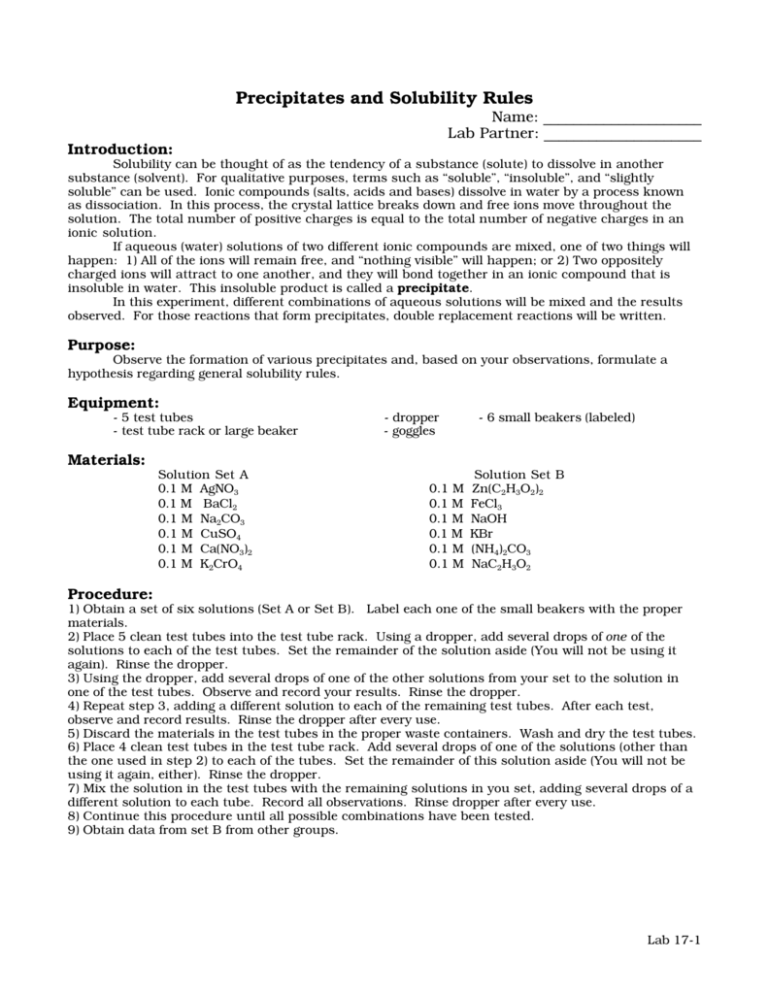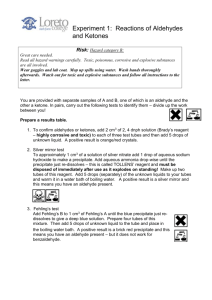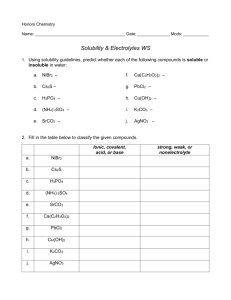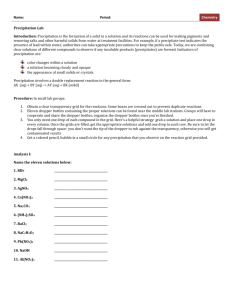Precipitates & Solubility Rules Lab Worksheet
advertisement

Precipitates and Solubility Rules Name: _____________________ Lab Partner: _____________________ Introduction: Solubility can be thought of as the tendency of a substance (solute) to dissolve in another substance (solvent). For qualitative purposes, terms such as “soluble”, “insoluble”, and “slightly soluble” can be used. Ionic compounds (salts, acids and bases) dissolve in water by a process known as dissociation. In this process, the crystal lattice breaks down and free ions move throughout the solution. The total number of positive charges is equal to the total number of negative charges in an ionic solution. If aqueous (water) solutions of two different ionic compounds are mixed, one of two things will happen: 1) All of the ions will remain free, and “nothing visible” will happen; or 2) Two oppositely charged ions will attract to one another, and they will bond together in an ionic compound that is insoluble in water. This insoluble product is called a precipitate. In this experiment, different combinations of aqueous solutions will be mixed and the results observed. For those reactions that form precipitates, double replacement reactions will be written. Purpose: Observe the formation of various precipitates and, based on your observations, formulate a hypothesis regarding general solubility rules. Equipment: - 5 test tubes - test tube rack or large beaker - dropper - goggles - 6 small beakers (labeled) Materials: Solution Set A 0.1 M AgNO3 0.1 M BaCl2 0.1 M Na2CO3 0.1 M CuSO4 0.1 M Ca(NO3)2 0.1 M K2CrO4 0.1 M 0.1 M 0.1 M 0.1 M 0.1 M 0.1 M Solution Set B Zn(C2H3O2)2 FeCl3 NaOH KBr (NH4)2CO3 NaC2H3O2 Procedure: 1) Obtain a set of six solutions (Set A or Set B). Label each one of the small beakers with the proper materials. 2) Place 5 clean test tubes into the test tube rack. Using a dropper, add several drops of one of the solutions to each of the test tubes. Set the remainder of the solution aside (You will not be using it again). Rinse the dropper. 3) Using the dropper, add several drops of one of the other solutions from your set to the solution in one of the test tubes. Observe and record your results. Rinse the dropper. 4) Repeat step 3, adding a different solution to each of the remaining test tubes. After each test, observe and record results. Rinse the dropper after every use. 5) Discard the materials in the test tubes in the proper waste containers. Wash and dry the test tubes. 6) Place 4 clean test tubes in the test tube rack. Add several drops of one of the solutions (other than the one used in step 2) to each of the tubes. Set the remainder of this solution aside (You will not be using it again, either). Rinse the dropper. 7) Mix the solution in the test tubes with the remaining solutions in you set, adding several drops of a different solution to each tube. Record all observations. Rinse dropper after every use. 8) Continue this procedure until all possible combinations have been tested. 9) Obtain data from set B from other groups. Lab 17-1 Observations and Data: There are fifteen combinations for each solution set. In each box, write “ppt.” for precipitate if a precipitate forms. If no precipitate forms, write “NR” (no reaction). Solution Set A AgNO3 BaCl2 Na2CO3 CuSO4 Ca(NO3)2 K2CrO4 Solution Set B Zn(C2H3O2)2 FeCl3 NaOH KBr (NH4)2CO3 NaC2H3O2 BaCl2 \\\\\\\\ FeCl3 \\\\\\\\ Na2CO3 \\\\\\\\ \\\\\\\\ NaOH \\\\\\\ \\\\\\\\ CuSO4 \\\\\\\\ \\\\\\\\ \\\\\\\\ KBr \\\\\\\\ \\\\\\\\ \\\\\\\\ Ca(NO3)2 \\\\\\\\ \\\\\\\\ \\\\\\\\ \\\\\\\\ (NH4)2CO3 \\\\\\\\ \\\\\\\\ \\\\\\\\ \\\\\\\\ Solubility Table: Lab 17-1 Calculations: 1) Write an equation for the dissociation of each salt in solution. Solution Set A Solution Set B Refer to the table of solubilities to assist you in writing the ionic equations for parts 2 and 3 in this section. 2) For each precipitate that was formed in this experiment, write an ionic equation for the double replacement reaction that occurred. Solution Set A Solution Set B Lab 17-1 3) Write a net ionic equation for the formation of each precipitate that was formed in this experiment. (Omit spectator ions) Solution Set A Solution Set B Conclusions and Questions: 1) Formulate a hypothesis about the relative tendency of the following ions to form soluble or insoluble + 22salts when in water: Na+, K+, NH4 , Ag+, NO3 , Cl-, CO3 , CrO4 , C2H3O2 2) Check your conclusion with the solubility table in your textbook (pg 574). How does your conclusion compare? Lab 17-1







